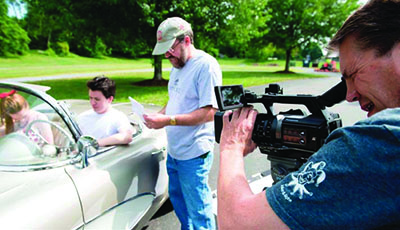Panasonic’s AJ-PX270 Micro P2 Camcorder

The Panasonic AJ-PX270 in use “on location”
Panasonic has now released VariCam technology in a much smaller, less expensive package. The AJ-PX270 Micro P2 Camera has almost all of the features of its more expensive older brother, in an extremely affordable, high-quality package. Now you can shoot with a camera that people will believe cost more than $20,000.
FEATURES
Featuring three one-third inch 1920 x 1080 CMOS sensors, Panasonic’s AJ-PX270 records up to 60p on one of two MicroP2 cards or on a full-size P2 card.
The Ultra High Reflective (UHR) glass on the front is an extremely powerful 28 mm to 616 mm (22X) lens that allows light to pass through 18 elements in 12 groups to provide the highest resolution images. The built-in lens hood can be open or closed via a latch, and you may operate the zoom function manually or through a servo motor drive.
There are three neutral density filters (1/4, 1/16, and 1/64) that are very easily engaged. Other operations are just as easy—the pushbutton focus assist, macro, auto iris, waveform monitor and zebra display. Access to the camera’s display mode check, gain control, white balance and menu buttons is straightforward too.
The audio controls are protectively housed beneath smoked plastic and feature the usual adjustment parameters. The rear of the camera contains the two micro P2 card slots, as well as a slot for a full-sized P2 card. To the right of the battery compartment there are USB2 and USB3 ports, and HDMI, LAN and a 12 VDC power input jack.
The viewfinder above the battery has the first five-inch organic light emitting diode (OLED) display I’ve seen in a camera. With a 1.76 MP resolution, this is the sharpest viewfinder you’ll currently see on a camcorder.
Camera connections include SDI out, audio via XLR, timecode in/out, genlock and focus/iris/zoom remote inputs.
Eight “user” buttons afford a plethora of assigned features, but what really separates the AJ-PX270 from less-qualified cameras is how you can perfectly control the images you shoot. The signal may be processed by using Dynamic Range Stretch (DRS), allowing a better dynamic range while keeping over- and under-exposed areas better balanced; or you can use one of seven gamma adjustment modes (Filmlike 1, 2, and 3; HD; SD; Film Rec; and Video Rec).
Holding the menu button down for five seconds opens the “Image Adjustment Function” of the menu. For those individuals such as myself who like to have complete control of parameters (and to experiment), this is where the gold is buried. Here you have access to such things as three-axis skin-tone color compensation, 12-axis color compensation for color gamut, detail image adjustment, vertical and horizontal detail, detail coring, color temperature, chroma level, color correction, knee, matrix, RB gain, white clip, black control, high color and gamma.
Variable frame and shooting rates are another serious user’s dream. The AJ-PX270’s variable frame rate in AVC-Intra100 features selectable speeds from one to 60 frames per second. Shooting modes range from huge file-sized AVC-Intra200 (available soon) to AVC-Intra100 and 50, AVCLongG50/ G25/G12, DVCPRO HD, Pro50 and DVCPRO. There’s also standard DV.
With three types of compression, AVC Intra uses a compression that’s intraframe (as the name implies) that features an extremely high-quality lossless video and 24-bit audio. AVC LongG uses a lower bitrate (25 or 50 Mbps) to record full 10-bit 4:2:2m HD video where field recording efficiency and log record times are required such as in reality TV production. LongG12 is a bit different; it was carefully optimized for wireless news workflows that require file-based delivery over cloud networks or 4G/LTE wireless systems. The lower bitrate makes this possible while still maintaining high quality. Lastly, there is AVC Proxy, which is a QuickTime H.264 that’s usually recorded at the same time as your main video, allowing smaller file sizes and metadata for offline post.
You can shoot in 1080/50 or 60p, 1080/60i, 1080/30p and 720p—not to mention all of the standard definition modes. As you can probably surmise, there is very little this camera cannot do and do well.
Lastly, capturing on microP2 cards would seem very similar to recording on SD cards. Actually, the only similarity is that the micro P2 cards are the same size. MicroP2 cards record at a significantly higher data rate and feature an internal RAID configuration where your images are redundantly stored in several areas at the same time, thus providing a safer way of storing data. I’ve only scratched the surface concerning this camera’s abilities. Using it for two shoots allowed me to put it through the paces to see if everything promised was true.
Micro P2 Versus SD Memory Cards
Although Micro P2 and SD cards may look alike, that’s where the difference ends. As a starter, the writing speed of the Micro P2 is about 350 Mbps and reading speeds bump 2Gbps. The write speed of an SD card is almost 80 Mbps and read speeds are far less than a Micro P2 at only a few hundred Mbps. Also, as mentioned, the Micro P2 features a RAID 5 structure, not just the fl ash memory available with an SD card.
You can use an SD card in the Panasonic AJ-PX270, but only at AVC-Intra 50, or the LongG format, as these use lower bitrates. The AVC-Intra 100 and other formats will not work with an SD card. The camera does not allow higher bitrate recordings on SD media. In an effort to ensure good recordings, it limits the records to 50Mbps. If you desire higher bitrates, you have to use Micro P2 cards.
Chuck Gloman
IN USE
My first shooting test involved a classic 1961 Corvette convertible and capturing in AVC-Intra100 at 1080/60p. Using an extremely expensive 64 GB MicroP2 card allowed me 36 minutes of storage space— enough for my five-minute epic. This was really the only drawback I found. Such proprietary storage is expensive!
Also, as I was working outdoors, the brilliant sun made the LCD screen very diffi cult to view. However, the OLED viewfinder proved to defi nitely be a gift from God. This is the sharpest, clearest, most accurate viewfinder I’ve seen on a camera at this price point. However, while the zebra buttons activate the desired functions, they don’t really stay on long enough for my liking. But with the sun going in and out and the highly reflective chrome on the car, the zebras were mandatory.
With the lithium-ion battery fully charged, by the end of our 90-minute shoot, we were down to one bar or one-quarter power.
When it was time to evaluate what we’d done I have to say that the images really looked amazing.
After the shooting wrapped I immediately removed the filled MicroP2 card and inserted it in my MacBook where I was able to access and edit all of the footage in Final Cut Pro 7.
If you’re curious about how the footage looked, check out my production on my link at YouTube: http://youtu.be/2jQpnULMmxk. The entire piece was shot with the PX270 operating in 1080/60p.
SUMMARY
In just a few words, the Panasonic AJPX270 is a camera that does it all—variable frame rates and shooting modes, total control of the recorded image for those who prefer a stylized approach to their footage, and an affordable camera package that makes all of this possible.
Chuck Gloman is an associate professor and chair of the TV/film department at DeSales University. He may be contacted atchuck.gloman@desales.edu.
FAST FACTS
APPLICATION
News, live action, feature work or anything that deserves high-quality image capture for those on a budget.
KEY FEATURES
Multiple shooting modes and speeds, personalized image manipulation, wireless transfer of material (with optional equipment)
PRICE
$5,750 (street price)
CONTACT
Panasonic System Communications Co. of North America 877-803-8492 www.panasonic.com/business/provideo
Get the TV Tech Newsletter
The professional video industry's #1 source for news, trends and product and tech information. Sign up below.
Chuck Gloman is Associate Professor with the TV/Film Department at DeSales University.

